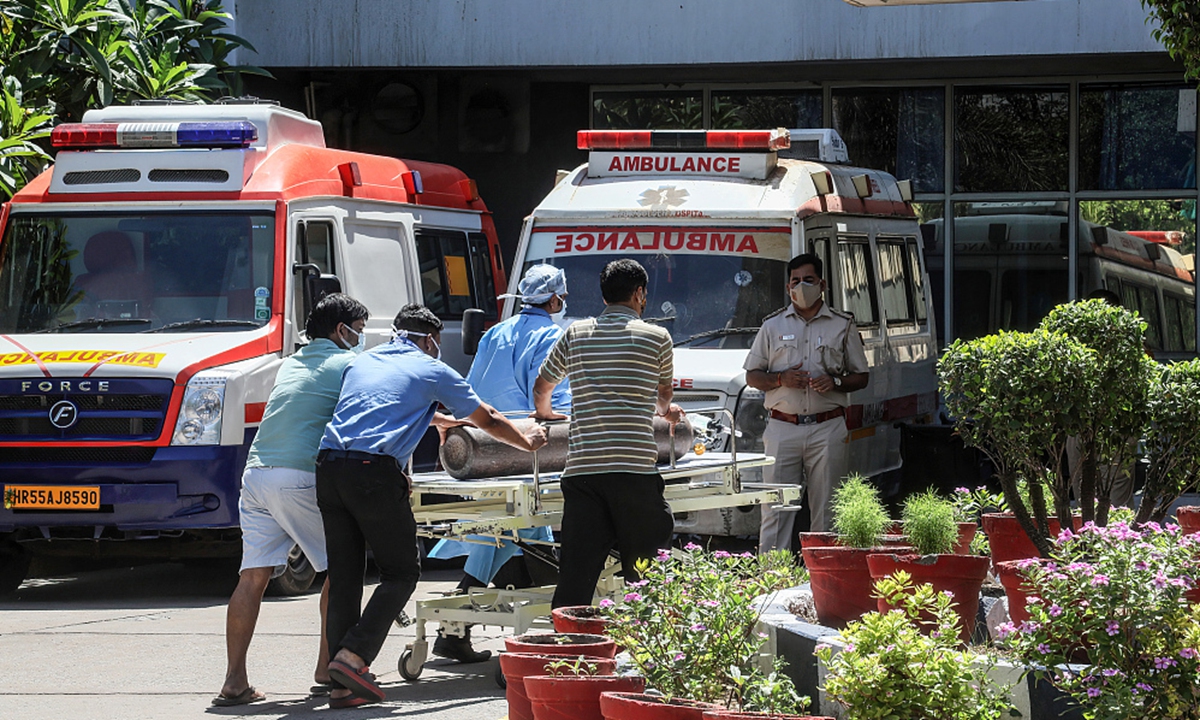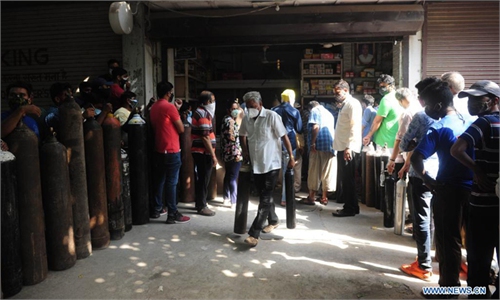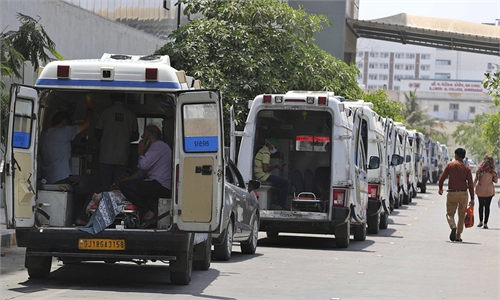India’s surging COVID-19 infections unlikely to impact China, but vigilance can't be relaxed ahead of May Day holidays: epidemiologists

India epidemic Photo: VCG
The spiraling COVID-19 epidemic situation in India has touched the hearts of the Chinese public in the past few days, while some netizens are also worried that the massive epidemic in India will have an impact on China. In response, senior Chinese experts pointed out that there is no need to worry too much, but China still needs to stay vigilant over imports of infection, and must not relax its prevention and control measures, especially ahead of the upcoming May Day holidays, which are expected to see 200 million Chinese on the move.
India's deadly surge in COVID-19 cases and death tolls has been making headlines all over the world in the recent days, with "no light at the end of the tunnel." Virologists expect the infection rate in the South Asian country is to continue to rise for another two to three weeks. The Indian government predicted on Sunday that this wave could peak in mid-May, by which time India will have up to 500,000 new confirmed cases per day.
Chinese netizens have expressed concerns about the epidemic in India, and fear whether it could spread to China, considering that India is an important neighbor of China and both countries have large populations.
In response, China's leading epidemiologists reassured the public that the outbreak in India is not expected to have much of an impact on China.
"China has taken strict precautions to prevent the importation of the disease from outside," Feng Zijian, a deputy director of the Chinese CDC, said in an interview with the Xinhua News Agency on Tuesday.
Nonetheless, Feng pointed out that China should remain vigilant over the risk of possible importation of the epidemic.
The rapid increase in the number of cases in India will also cause exports of cases to neighboring countries, Feng said. "Recently, a number of India's neighboring countries, including Nepal, have been witnessing more COVID-19 cases, which also puts pressure on China."
China will soon celebrate the May Day holidays, one of the longest vacations of the year. With this massive outbreak underway in neighboring India, authorities are also reminding domestic tourists not to relax their precautions when traveling.
On Monday, the China CDC issued a bulletin reminding the public to avoid unnecessary cross-border travels and asking travelers to observe themselves for 14 days after the end of their trips and to seek medical advice in the event of suspicious symptoms.
Feng believes that China's successful experience in fighting against the epidemic is also worth learning from for India.
There should be strict restrictions to prevent imports of the epidemic, Feng said. "This includes controlling the number of people entering the country and implementing double-negative nucleic acid testing and antibody testing for people entering the country, as well as 14 days of intensive quarantine observation after entry."
"The government's capability is critical for the effective implementation of these measures, while grassroots social organizations and communities must have a very strong mobilization," Feng said.
Feng also pointed out that all the response measures taken by the government and the public require a prerequisite - a strong health care system.
However, the public health system in many parts of India has collapsed and is unable to provide timely treatment to patients, a situation that is reported to have caused the death toll to soar and worsened the outbreak, media reported. Since April 20, the daily death toll due to COVID-19 has exceeded 2,000 in India.
A main reason behind the worsening situation is the pressure on medical resources, Zhang Wenhong, China's leading infectious disease expert, said on Monday.
"Many hospitals cannot even keep up with the oxygen supply," Zhang said. "Many young patients died when they could have survived with just a sip of oxygen to breathe in. What India needs most at the moment is oxygen, which is better than any medicine and can reduce deaths among young patients."
To solve this problem, China shipped 800 concentrators to India on Monday and will send another 10,000 within a week.
Moreover, India is also unlikely to reach herd immunity through a pandemic, Zhang said.
"India's current infection rate is no more than 2%, and it will take decades to reach an estimated 70% level of herd immunity," Zhang said, adding that possible herd immunity would take millions of additional deaths. "Thus, there is a very high degree of uncertainty about the subsequent situation in India."
Zhang pointed out that for the current situation in India, urgent vaccination is of little use. The epidemic can only be quelled after extremely strict public health measures and good cooperation between the government and the people are taken immediately.
However, in the long run, populous countries need to accelerate their vaccination and coverage as soon as possible, experts say.
"India and China are both countries with vaccine production capacity," Feng said. "Only through a high level of population immunization can the impact of the COVID-19 pandemic be fundamentally mitigated or ended."
Global Times


